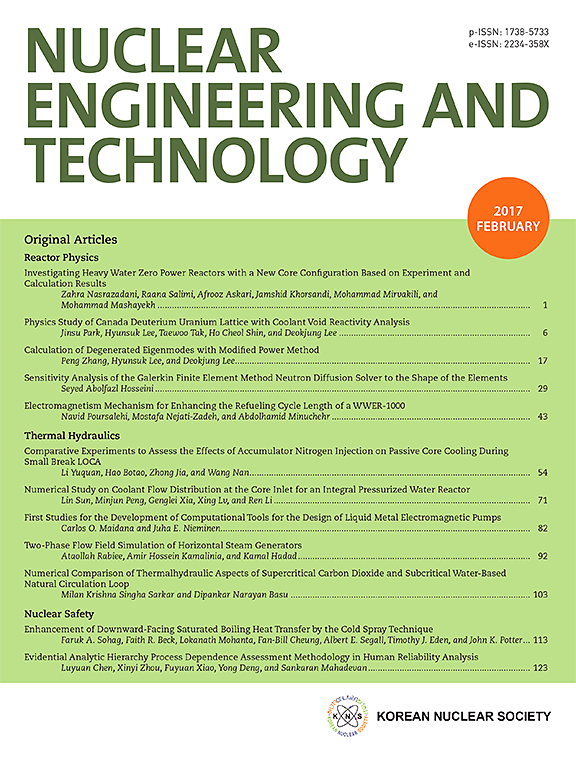利用物理信息神经计算进行核聚变等离子体的传输模拟
IF 2.6
3区 工程技术
Q1 NUCLEAR SCIENCE & TECHNOLOGY
引用次数: 0
摘要
几十年来,托卡马克中的等离子体输运模拟一直使用有限差分法(FDM),这是一种相对简单的方案,用于求解输运方程(一组耦合的时变偏微分方程)。在这种有限差分法中,单次放电通常需要超过 O(105) 个时间步长,以缓解僵化传输系数引起的数值不稳定性。这需要大量的计算时间,因为需要以串行方式反复调用昂贵的传输模型,其数量与时间步数成正比。此外,FDM 的单向计算很难预测初始条件之前的区域或应用额外的时间约束。在本研究中,我们讨论了使用基于物理信息神经网络(PINN)的新方案来解决等离子体传输问题。PINN 通过迭代更新将时空坐标映射到等离子体状态的函数,逐步减少传输方程中的误差。PINN 所需的更新次数比 FDM 中的按时间顺序迭代少几个数量级。此外,它不受有限网格引起的数值不稳定性的影响,可以在任意时空约束条件下进行更多用途的半预测模拟。本文通过与 FDM 的比较,讨论了使用 PINN 的托卡马克输运求解器的特点和潜力,以及其缺点和挑战。本文章由计算机程序翻译,如有差异,请以英文原文为准。
Leveraging physics-informed neural computing for transport simulations of nuclear fusion plasmas
For decades, plasma transport simulations in tokamaks have used the finite difference method (FDM), a relatively simple scheme to solve the transport equations, a coupled set of time-dependent partial differential equations. In this FDM approach, typically over time steps are needed for a single discharge, to mitigate numerical instabilities induced by stiff transport coefficients. It requires significant computing time as costly transport models are repeatedly called in a serial manner, proportional to the number of time steps. Additionally, the unidirectional calculations of FDM make it difficult to predict regions prior to the initial condition or apply additional temporal constraints. In this study, we discuss using a new scheme to solve plasma transport based on physics-informed neural networks (PINNs). PINN iteratively updates a function that maps spatiotemporal coordinates to plasma states, gradually reducing errors in transport equations. The required number of updates in PINNs is several orders of magnitude less than the chronological iterations in FDM. Furthermore, it is free from numerical instabilities arising from finite grids and enables more versatile semi-predictive simulations with arbitrary spatiotemporal constraints. In this paper, we discuss the features and potentials of the tokamak transport solver using PINNs through comparisons with FDM, and also its drawbacks and challenges.
求助全文
通过发布文献求助,成功后即可免费获取论文全文。
去求助
来源期刊

Nuclear Engineering and Technology
工程技术-核科学技术
CiteScore
4.80
自引率
7.40%
发文量
431
审稿时长
3.5 months
期刊介绍:
Nuclear Engineering and Technology (NET), an international journal of the Korean Nuclear Society (KNS), publishes peer-reviewed papers on original research, ideas and developments in all areas of the field of nuclear science and technology. NET bimonthly publishes original articles, reviews, and technical notes. The journal is listed in the Science Citation Index Expanded (SCIE) of Thomson Reuters.
NET covers all fields for peaceful utilization of nuclear energy and radiation as follows:
1) Reactor Physics
2) Thermal Hydraulics
3) Nuclear Safety
4) Nuclear I&C
5) Nuclear Physics, Fusion, and Laser Technology
6) Nuclear Fuel Cycle and Radioactive Waste Management
7) Nuclear Fuel and Reactor Materials
8) Radiation Application
9) Radiation Protection
10) Nuclear Structural Analysis and Plant Management & Maintenance
11) Nuclear Policy, Economics, and Human Resource Development
 求助内容:
求助内容: 应助结果提醒方式:
应助结果提醒方式:


